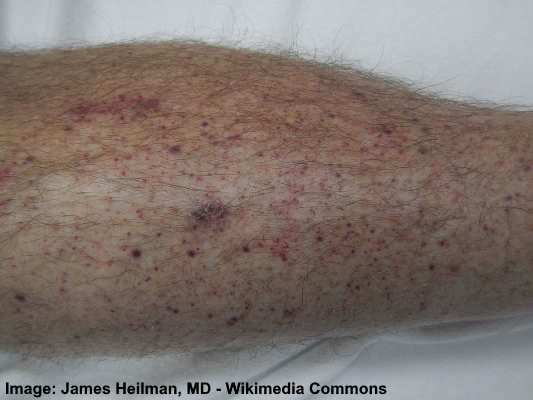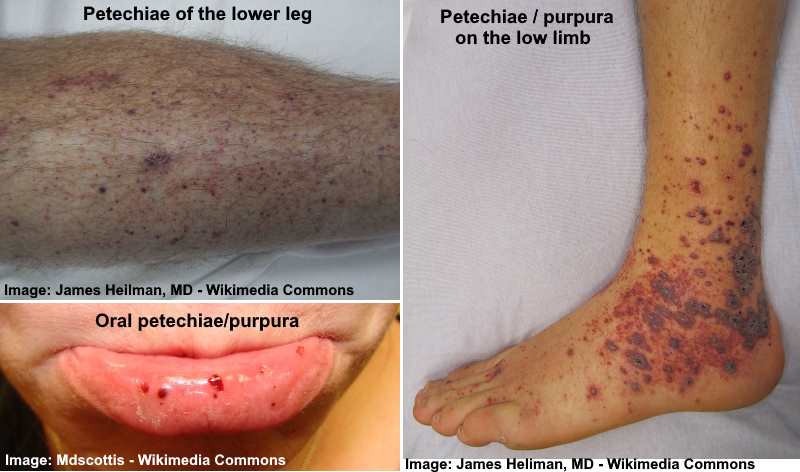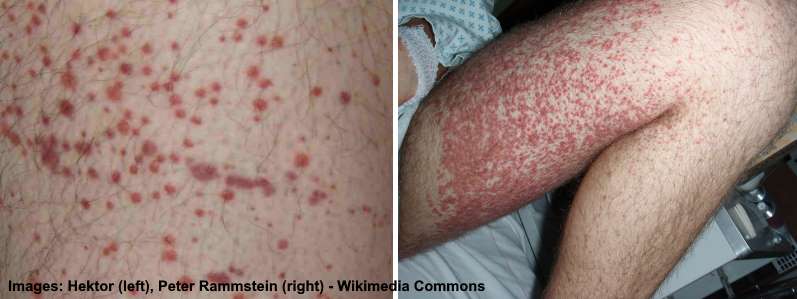Petechiae: Causes, Symptoms and Treatments (Including Images)

Petechiae look like flat small red, brown, or purple spots on the skin. Petechiae spots form when tiny capillaries break and cause slight bleeding under the skin. The tiny darkened spots usually form in clusters and are called a petechial rash.
You may notice a petechiae rash on your legs, feet, arms, or upper body for a number of reasons. Prolonged straining or trauma can cause a petechial rash on the face or other body parts because of light bleeding under the skin. Also, some medications or medical conditions can also cause tiny purple spots in your mouth, throat, upper body, or legs.
The difference between a petechial rash and common rash is that the little red or purple spots in petechiae don’t turn white when you press on the skin whereas rash does.
Many of the reasons for the appearance of petechiae are harmless; however, the bleeding from broken blood vessels under the skin can also have a serious cause. Therefore, you should see a doctor about any unexplained clusters of petechiae spots.
What is Petechiae and What Does Petechiae Rash Look Like?
Doctors describe petechiae as small, pinpoint red spots that are not raised. The flat pinpoint spots form when blood leaks into the layers of the skin, causing a rash-like appearance.1
The publication StatPearls says that petechiae spots measure no larger than 2 or 3 mm across. These tiny red or purple spots generally form in groups and look like a red rash. Petechial rashes are described as non-blanching because they don’t change color when pressed.2
Petechial rashes on children usually require examination by a doctor to diagnose the cause of the bleeding under the skin.
Purpuric Rash vs. Petechial Rash
There is a slight difference between a purpuric rash and a petechial rash.
The causes of a petechial rash and purpura are usually the same. Purpura or purpuric rashes are also caused by bleeding in the intradermal layers of the skin. The difference between the two is the size of the spots under the skin.
The journal BMJ reports that a purpuric rash comprises of red or brown spots caused by bleeding into the skin. The spots are purpuric if they are over 2 or 3 mm in size, whereas smaller petechiae spots are 1-2 mm in diameter. Larger red or purples spots in the layers of the skin can be called purpura or bruising.3
Symptoms of Petechiae
Depending on the cause of petechiae spots under your skin, you may have other symptoms. Knowing the accompanying symptoms with a petechial rash can help doctors diagnose the source of bleeding under the skin.
Along with clusters of tiny red dots on your skin, you may also have any of the following:
- Fever with a rash that doesn’t turn white when pressed (potentially serious in children)
- Fatigue
- Bouts of coughing or vomiting due to a viral or upper respiratory infection
- Rapid heart rate and difficulty breathing in cases of sepsis
- Enlarged lymph nodes in your neck
- Pain when swallowing and evidence of petechiae in your mouth or throat (oral petechiae)
- Swollen tonsils
- Pinpoint reddish spots on your legs if you have low blood platelet count
Petechiae on legs and feet
Tiny purple spots on the skin are often connected with small blood vessels and capillaries and often appear on the lower legs, feet, and ankles. Many of the causes of petechiae can result in a petechial rash on the front or side of the legs or ankles.
However petechiae can affect other body parts such as the back, arms, abdomen, chest, face and neck.
Causes of Petechiae
Let’s look at some of the reasons for petechiae that are not connected with serious underlying medical conditions.
Prolonged straining
Any kind of prolonged straining can cause light hemorrhaging of your capillaries, resulting in tiny red or freckle-like spots on your skin.
Doctors from the Mayo Clinic report that activities such as weight lifting or giving birth can put a strain on your capillaries. This can result in bleeding under the skin and can cause petechiae on the face or upper body.4
You may also notice pinpoint brown spots on your face or neck if you suffer from a viral infection or gastroenteritis. For example, the Indian Dermatology Online Journal reported that forceful vomiting can cause facial petechiae. In these cases, petechiae only last a few days as the skin heals itself and signs of bleeding in the skin disappear.5
Also, chronic coughing could cause a petechial rash in your mouth or on your lips. A medical journal from 2011 reported that mucosal petechiae were observed in a patient with severe coughing.6
Strenuous activity
Other types of strenuous activity can cause a petechial rash on your feet, especially on your heel.
The Journal of the American Academy of Dermatology reported that some marathon runners experience petechiae on their heel. This type of harmless bleeding under the skin occurs mainly where there is less protection from the thick skin of the heel. Doctors say that petechiae on the feet usually lasts about 2 or 3 weeks.7
Trauma to the skin
Injury to your skin can cause bleeding in the layers of the skin that may result in petechia on legs, feet, arms as well as other skin areas.
Some types of trauma to the skin that cause tiny blood spots on the skin can be due to skin conditions or physical trauma.
For example, the journal Cureus reported that self-massaging with a softball could leave a petechial rash on the upper back and shoulder. The pressure from the ball can cause light hemorrhaging under the skin that looks like clusters of tiny pinpoint brown spots.8
Also, the Journal of Clinical Medicine reports that seborrheic dermatitis can result in tiny reddish brown pustules that are characteristic of a petechial rash.9
Medical Conditions that Can Cause Petechiae and Petechial Rash
More serious reasons for purpuric rashes that are formed by tiny flat spots are usually due to medical conditions.
Vitamin deficiency
Vitamin deficiencies can result in weakened capillaries and light bleeding under the skin that causes small purple spots. Two common vitamin deficiencies that cause petechial rashes are a lack of vitamin K and vitamin C.
The journal BMJ Case Reports says that vitamin C deficiencies are still common in the developed world. Not getting enough vitamins from your diet can result in poor health and even signs of scurvy. This can result in rashes of tiny red or purple spots on the legs as well as easy bruising and gum disease.10
Dr. Dieu-Thu Nguyen-Khoa on Medscape says that vitamin K is essential for blood coagulation. A lack of vitamin K from the diet can result in petechiae rashes and bleeding that is difficult to stop.11
Thrombocytopenia (low blood platelet count)
A low platelet count can result in bleeding under the skin that can cause petechial or purpuric rashes in different areas such as the legs, feet, arms or chest.
Platelets are necessary to help clot blood, and not having enough platelets can result in easy bruising. Low platelet counts are often detected in a blood test to check red blood cells.
The journal F1000 Prime Reports says that a platelet count of lower than 20 x 109/L can result in petechiae, purpura lesions, or ecchymoses (large patches of bruising).12
Celiac disease
Celiac disease can cause petechiae rashes on different parts of the body such as the legs, arms or feet.
According to the journal Gastroenterology Research and Practice, celiac disease can cause a number of skin conditions. In fact, scientists have found that the celiac disease often causes vasculitis (an inflammation of the blood vessels) that affects the skin. This can result in petechial “eruptions” on various parts of the body.13
Vasculitis
Vasculitis affects the capillaries in the skin and can cause a petechiae rash or purpura rash.
Inflammation of the small blood vessels can cause them to rupture and cause light bleeding in the skin. Dr. Alexandra Villa-Forte, who specializes in rheumatic diseases, says that vasculitis can be caused by a number of conditions. The result is usually tiny to large blood spots on the lower legs.14
Sepsis
Infection in your bloodstream is a potentially life-threatening condition that can manifest itself as rashes of small to large purple or red spots.
Sepsis occurs when an infection causes an inflammatory response in the body.
Dr. Andre Kalil from the Department of Infectious Diseases at the University of Nebraska reports that sepsis can cause multiple complications. At the onset, sepsis can cause fever, confusion, and difficulty breathing. As the condition progresses, any part of the body can be affected. Petechiae, purpura, and skin ulcers are dermatological symptoms of sepsis.15
Sepsis has other signs and symptoms that you should not ignore.
Petechiae from Infectious Conditions
Petechiae can be symptomatic of some bacterial or viral infections.
Strep throat
A common symptom of strep throat is a red petechial rash on the back of the throat or tonsils.
Doctors on PubMed Health report that a bacterial infection of the throat can cause a fever, sore throat, nausea, and vomiting. You may also notice a rash of tiny red dots in your mouth. Other signs of a strep throat are white spots on your tonsils, pain when swallowing, and swollen lymph nodes.16
You can read more about strep throat in my article about the best natural remedies for strep throat.
Scarlet fever
Strep throat can lead to scarlet fever that can cause a large petechial rash on the upper body and face. As with strep throat, scarlet fever may cause red dots at the back of your throat.
According to dermatologist Dr. Bahman Sotoodian, scarlet fever can cause a petechial rash in the mouth. However, petechiae are often seen in the armpits, back of the elbows, and upper body. Scarlet fever can also cause a sandpaper-like rash on the upper body.17
Mononucleosis
Another infectious condition that can result in petechiae in the mucous membranes of your mouth is mononucleosis. In some cases, mononucleosis results in white spots on the throat.
Mononucleosis (mono) is caused by the Epstein-Barr virus (EBV). The journal Clinical & Translational Immunology reports that a sore throat and swollen lymph glands are the most common mono symptoms. However, in some cases, mono can cause oral petechiae, abdominal pain, nausea, and swollen eyelids.18
Other infectious diseases that cause petechiae
Some other reasons why patches of tiny flat red spots that look like freckles can appear include:19
- Cytomegalovirus infection. This viral infection causes patches of purple dots or lesions to appear and can affect liver function.
- Rocky Mountain spotted fever. This is a tick-borne disease that can severely affect your heart or kidneys. Rocky Mountain spotted fever causes a petechial rash that starts at your wrists and ankles and spreads up your arms and legs.
- Meningococcemia. A rare bacterial infection that can cause meningitis. The meningitis rash does not fade under pressure.
- Viral hemorrhagic fevers. These types of fevers are more common in tropical areas of the world and include dengue fever, Ebola, and Yellow fever.
Other Causes of Petechial Rashes
Side effect of some medications
Certain drugs or medications can cause you to have mild petechiae on your arms, legs, upper body, or face.
The reason for petechiae caused by medication is usually due to some antibiotics, blood thinners, or NSAIDs causing platelet count to drop. For example, a report from 2007 states that some of the medications associated with petechiae can include:20
- Antibiotics (penicillin)
- Anti-coagulants (heparin)
- Non-steroidal anti-inflammatory drugs (NSAIDs)
- Anti-diabetic medication
- Diuretics
- Anti-malaria drugs (quinine and quinidine)
Endocarditis
A bacterial or fungal infection of the tissue surrounding the heart can cause a petechiae-like rash on your legs.
According to Dr. John L. Brusch from Harvard Medical School, petechiae occurs in around half of the patients with endocarditis. Sometimes, larger patches of purple skin show up on the hands and fingertips. The symptoms of endocarditis also include heart murmurs and low-grade fever.21
Leukemia
Petechiae rashes and bleeding easily are two of the many symptoms of leukemia.
A study on the oral signs of leukemia from 2014 found that some of the early signs of leukemia include petechiae in the mouth, bleeding gums, and enlarged gums. This may be accompanied by fatigue, anemia, and general weakness.22
Of course, there are many other reasons why petechiae rashes can appear around the mouth.
Autoimmune conditions
Petechiae spots that don’t itch can appear as a symptom of certain autoimmune conditions like lupus.
The U.S. National Library of Medicine reports that systematic lupus erythematosus (SLE) can cause tiny red spots in the skin. This is due to lupus interfering with clotting mechanisms in the blood. Lupus can also cause vasculitis which can cause petechiae rashes to affect the legs.23
Influenza A virus
The H1N1 influenza A virus can also result in tiny purple spots on the skin similar to a petechial rash.
The journal Influenza and Other Respiratory Viruses reported in 2011 that the H1N1 flu virus can cause a non-itchy petechiae rash. Although not as common as severe coughing, fever, aching muscles, or a sore throat, body rashes can sometimes occur if you have the flu. This was described by doctors as a rash with a fever.24
Treatments for Petechiae
If you notice a petechiae rash on any part of your body, it is usually best to see your doctor for a proper diagnosis.
Although the cause of a freckle-like rashes appearing on your face could be from severe coughing or vomiting, it could be caused by a more serious condition.
If petechiae were the result of a viral or bacterial infection, the clusters of tiny red spots should go away when the infection is treated.
Red rashes characteristic of petechiae that are the result of medication should disappear when you change your medication or stop taking it.
When to See a Doctor
If you notice a rash on your skin that doesn’t become pale when you press on it, you should call your doctor. Doctors from Harvard Medical School say that conditions causing bleeding under the skin can be very serious.
Doctors also warn that petechial rashes in children can quickly develop into more serious conditions. Therefore, it is best to take your child to the emergency room rather than wait and see if it gets better.25
Related articles:



